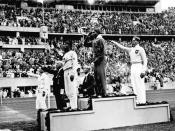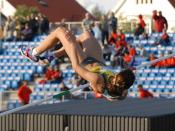Origin and History:
Like sprinting, high jump and other field events all originated at the Olympic games in Greece, 776 B.C. After Roman Emperor Theodosius I abolished the games in 393 B.C. because he thought them to be a pagan activity, high jump was popular in England, 1834, along with other events mainly because spectators enjoyed betting on the athletes. It then continued to be part of the Olympic games, the world championships, and the Commonwealth games amongst many more to this day.
How it's done:
Historically, a variety of techniques have been used by competitors to clear the bar. However, in the 1968 summer Olympics, Dick Fosbury won a gold medal in the high jump with his method. It was to sprint diagonally towards the bar, then curve and leap backwards over the bar. This method was then called the Fosbury Flop and is used most of the time with elite competitors.
Another way to jump is called the western roll. Western roll clearance is a layout position on the top of the bar, with the side of the body nearly parallel to the ground. As the kicking leg (right) is forcefully lifted, the takeoff leg (left) snaps underneath the right. Almost instantly the body turns toward the bar. Going over, the body's position is nearly parallel with the ground, with the head slightly raised. As the right leg kicks up, the left arm also extends and follows the right leg by a few inches across the bar.
In modern high jump, a fibreglassor aluminium bar of approximately 4 metres in length, with a round (or triangular or square) cross-section for most of its length but with two square resting points at each end, is placed at a measured height on two "uprights" which allow the bar to rest...



High Jump
This was a good essay on a track and field event which I always found challenging. I liked how you began your report with a brief history of the high jump. Your explanation of how it's done was thorough and informative. The training tips provided were particularly useful. Your headings made the essay very easy to read. Great job!
8 out of 8 people found this comment useful.